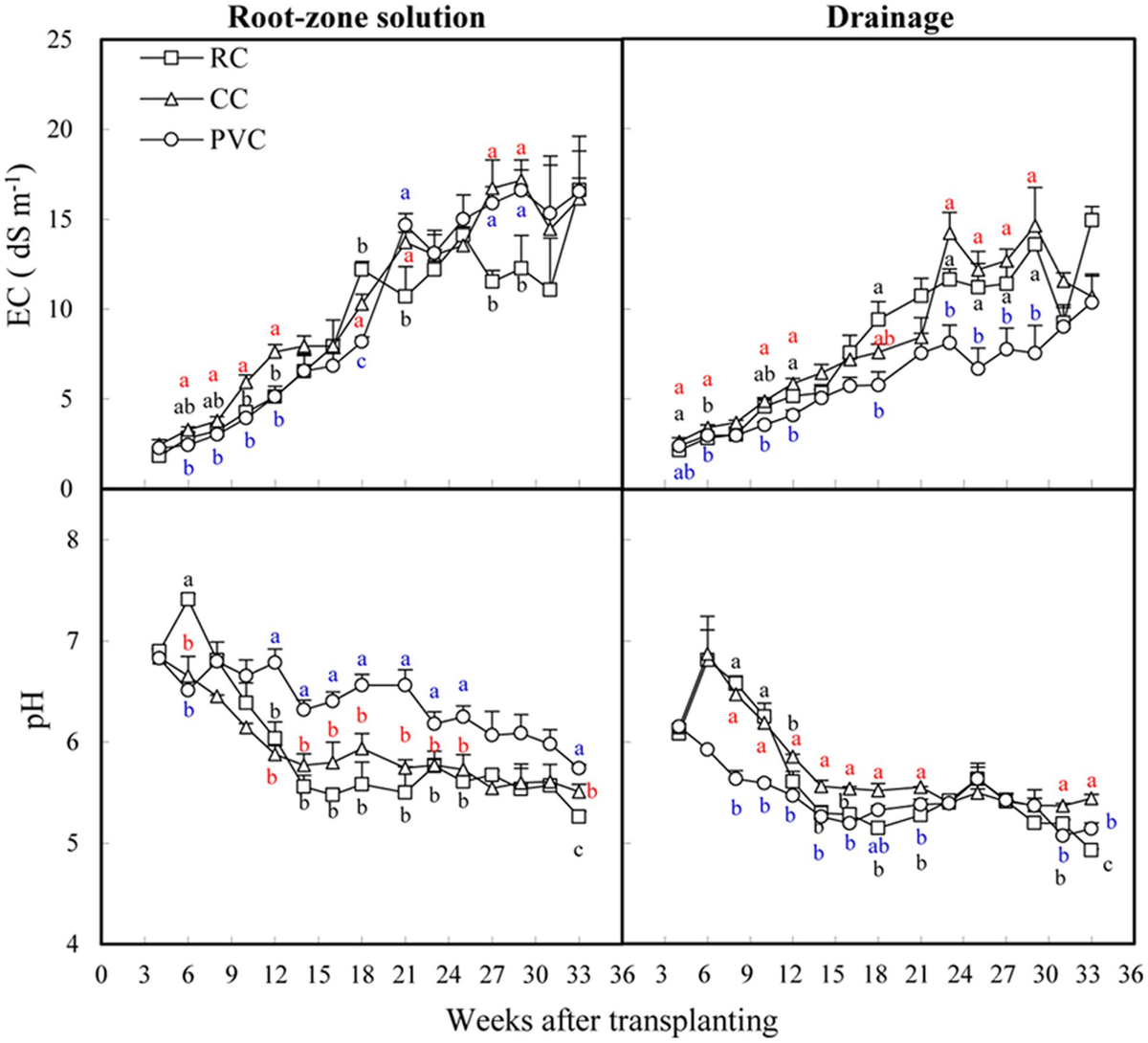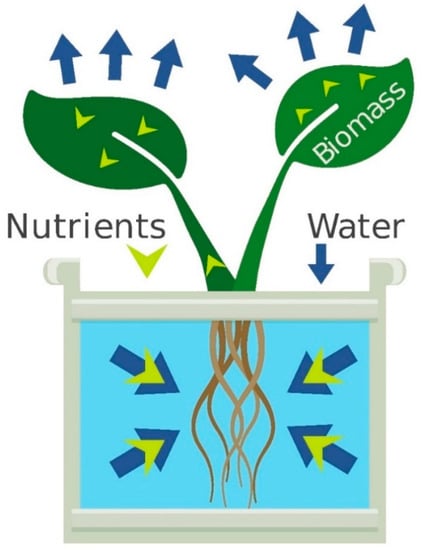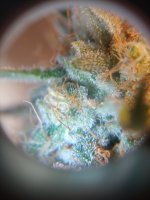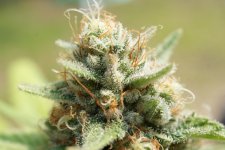How many PAR at tops?
You are using an out of date browser. It may not display this or other websites correctly.
You should upgrade or use an alternative browser.
You should upgrade or use an alternative browser.
LED and BUD QUALITY
- Thread starter Tropical Sun
- Start date
Im no longer using a par meter but since were in week one im around 650 ppfd. Ill bump that up to 750 this week with their reservoir change.How many PAR at tops?
Cerathule
Well-known member
I can't see it. Searching finds chat about outdoors with very shrunken heads though, for someones second time, with different plants.
I also see that fast filling thichs can bust open.
I also see, they are made of silicone to a great extent.
No they are not made of Si. Cannabis just has a tendency to accumulate Si in the bases of the trichomes. That is a heavy indicator that here the Si is at the end of its path and then just forms complexes at a certain concentration gradient. Just similar to what happens with excess Ca. Cannabis doesn't need Si at all and it can complete its lifecycle just fine even without it though Si has some beneficial qualities. Just look at a trichome in a micrograph and you see lots of cells there, these cells contain all kinds of elements, water, resin, and the cells do have a cellwall, specific organs and whatnot just like many other end-differentiated cells of the plant in its other parts.I'm looking at the idea that fast expansion could lead to them exploding. Which is the term used in a posters comments. No papers were provided.
Lol "exploding trichomes" /facepalm
Was just wondering advantage of rockwool over coco. If overfed coco can develop buildup of nutrients. Does rockwool have that issue? How much is per plant cost?Im no longer using a par meter but since were in week one im around 650 ppfd. Ill bump that up to 750 this week with their reservoir change.
If you maintain reservoirs changes and monitor ph/ec regularly in an ebb and flow system its hard to have a build up issue. Per plant cost is too variable to calculate currently.Was just wondering advantage of rockwool over coco. If overfed coco can develop buildup of nutrients. Does rockwool have that issue? How much is per plant cost?
Ca++
Well-known member
Yes, I shared the 'exploding' term, to indicate the validity of the posters information. I in no way wish to share what I wrote, as being my own opinion.No they are not made of Si. Cannabis just has a tendency to accumulate Si in the bases of the trichomes. That is a heavy indicator that here the Si is at the end of its path and then just forms complexes at a certain concentration gradient. Just similar to what happens with excess Ca. Cannabis doesn't need Si at all and it can complete its lifecycle just fine even without it though Si has some beneficial qualities. Just look at a trichome in a micrograph and you see lots of cells there, these cells contain all kinds of elements, water, resin, and the cells do have a cellwall, specific organs and whatnot just like many other end-differentiated cells of the plant in its other parts.
Lol "exploding trichomes" /facepalm
I feel a bit of school boy error crept in on my behalf, with the Si making tichs statement. That was actually from a better source, but I have done hydro with no effort to introduce Si, and so can't even start to rationalise it. Except for as you say. Which is just decoration.
i thought you might find this an interesting read regarding silicon and plants.Yes, I shared the 'exploding' term, to indicate the validity of the posters information. I in no way wish to share what I wrote, as being my own opinion.
I feel a bit of school boy error crept in on my behalf, with the Si making tichs statement. That was actually from a better source, but I have done hydro with no effort to introduce Si, and so can't even start to rationalise it. Except for as you say. Which is just decoration.

Frontiers | Silicon and Plants: Current Knowledge and Technological Perspectives
Elemental silicon (Si), after oxygen, is the second most abundant element in the earth’s crust, which is mainly composed of silicates. Si is not considered e...
APPSS under HLG diablo.. I get more yellowing under this LED. The quality is still very good.

Last edited:
Ca++
Well-known member
Phew. 10 minutes in, the page slider had hardly moved. I was getting a bit skippy.i thought you might find this an interesting read regarding silicon and plants.

Frontiers | Silicon and Plants: Current Knowledge and Technological Perspectives
Elemental silicon (Si), after oxygen, is the second most abundant element in the earth’s crust, which is mainly composed of silicates. Si is not considered e...www.frontiersin.org
There might of been a bit between the lines there, about hemp taking on more than it's analogues. Like the tommies roots rejecting it, which is a plant that often has Ca issues. Yet by making nano particles, they could get it to seeds, over doubling the weight. Likewise the Maize study used nano particles. Then on topic, the cannabis rope plant took it at the root, though could benefit from foliar nano application. It's a pity seed and oil were not looked at. The flax treated with nano particles, made more oil. Is flax an oil crop? They spoke of cannabis fiber plant's better resistance to poisonous metals, as if skirting around the topic I was actually interested in.
'The Bastards' That took half hour.
Edit: I saw study about the difficulty of getting it to our crop at the root. They answered this, with Si applied to a substrate they mixed in. I think it was polystyrene. As my brain phone rang, reminding me that polystyrene was fireproofed with Si decades ago.
Last edited:
Ca++
Well-known member
APPSS under HLG diablo.. I get mote yellowing under this LED. The quality is still very good.

Some damaging features there. The 660 peak is quite narrow, leaving it high and isolated. This can lead to photo-bleaching we can see, but I think here, could fall short of that. Bleached tissue tends to remain good, but unsightly. The blue peak is also a concern. The idea it's damaging is gaining more and more weight, with every study. We need a bit, but the 5% of HPS seems enough at our high illumination levels.
Combined, we could have the answer.
i'm mixing diatomaceous earth into a perlite base right now. DE is amorphous and has no crystalline structure so it is plant available.Phew. 10 minutes in, the page slider had hardly moved. I was getting a bit skippy.
There might of been a bit between the lines there, about hemp taking on more than it's analogues. Like the tommies roots rejecting it, which is a plant that often has Ca issues. Yet by making nano particles, they could get it to seeds, over doubling the weight. Likewise the Maize study used nano particles. Then on topic, the cannabis rope plant took it at the root, though could benefit from foliar nano application. It's a pity seed and oil were not looked at. The flax treated with nano particles, made more oil. Is flax an oil crop? They spoke of cannabis fiber plant's better resistance to poisonous metals, as if skirting around the topic I was actually interested in.
'The Bastards' That took half hour.
Edit: I saw study about the difficulty of getting it to our crop at the root. They answered this, with Si applied to a substrate they mixed in. I think it was polystyrene. As my brain phone rang, reminding me that polystyrene was fireproofed with Si decades ago.
i have used expensive mono silicic acid quite a bit but i feel i'm seeing the same results with cheap DE.
this is the inherent problem when using the phosphor coating method of producing the desired color temperature.
Some damaging features there. The 660 peak is quite narrow, leaving it high and isolated. This can lead to photo-bleaching we can see, but I think here, could fall short of that. Bleached tissue tends to remain good, but unsightly. The blue peak is also a concern. The idea it's damaging is gaining more and more weight, with every study. We need a bit, but the 5% of HPS seems enough at our high illumination levels.
Combined, we could have the answer.
all phosphor-coated diodes start life as a blue diode and are then coated to achieve color temp.
even warm whites 2700-3000k will produce huge blue spikes but if you start with the lowest blue ratio warm white and then add dark red and far-red you can shift the overall ratio more towards the red end of the spectrum. this is for flowering.
using this combination in veg will cause elongation. i think this is why we should have tunable or adjustable spectrum lights.
the phosphor coating method is also the cheapest way to produce "white" light and that explains why most manufacturers use them.
the ideal way to produce white light is with combinations of specific frequency diodes at specific ratios.
it is the most expensive way to do it by far but if a light were built like this and tunable for each phase of plant life we would really have something. i'm sure they would cost thousands of dollars per fixture.
Dr.Dutch
Well-known member
Spoiler because it feels a bit off topic. But to answer the questions

 www.frontiersin.org
www.frontiersin.org
In several videos he explains the benefits for cannabis (e.g. maximizing cannabis yields with dr. bruce bugbee).

Also in general, he recommends the use of silicon. Many plants benefit from an additional silicon


 www.mdpi.com
www.mdpi.com
Coco seems to be much more similar to rockwool than one often reads. Hardly any differences, especially no significant ones, were found in this study.Was just wondering advantage of rockwool over coco. If overfed coco can develop buildup of nutrients. Does rockwool have that issue? How much is per plant cost?

Frontiers | Comparison of Coconut Coir, Rockwool, and Peat Cultivations for Tomato Production: Nutrient Balance, Plant Growth and Fruit Quality
Rockwool (RC) and peat are two common substrates used worldwide in horticultural crop production. In recent years environmental and ecological concerns raise...
Do you have you sources for that?No they are not made of Si. Cannabis just has a tendency to accumulate Si in the bases of the trichomes. That is a heavy indicator that here the Si is at the end of its path and then just forms complexes at a certain concentration gradient. Just similar to what happens with excess Ca. Cannabis doesn't need Si at all and it can complete its lifecycle just fine even without it though Si has some beneficial qualities. Just look at a trichome in a micrograph and you see lots of cells there, these cells contain all kinds of elements, water, resin, and the cells do have a cellwall, specific organs and whatnot just like many other end-differentiated cells of the plant in its other parts.
Using silica for cannabis is recommended by Bugbee.I feel a bit of school boy error crept in on my behalf, with the Si making tichs statement. That was actually from a better source, but I have done hydro with no effort to introduce Si, and so can't even start to rationalise it. Except for as you say. Which is just decoration.
In several videos he explains the benefits for cannabis (e.g. maximizing cannabis yields with dr. bruce bugbee).
Also in general, he recommends the use of silicon. Many plants benefit from an additional silicon

Principles of Nutrient and Water Management for Indoor Agriculture
Mass balance principles are a cornerstone of efficient fertilizer use and can be utilized to optimize plant nutrition without discarding or leaching solution. Here, we describe the maintenance of closed hydroponic and soilless substrate systems based on mass balance. Water removed by...
i've been using the mass balance method for feeding plants in a closed-loop recirculating system since march of 2010. i have experimented with dumping and changing reservoirs at different points of life such as at the beginning of flower or week 4 of flower dumping and trying a bloom formula, and so on.Spoiler because it feels a bit off topic. But to answer the questions
Coco seems to be much more similar to rockwool than one often reads. Hardly any differences, especially no significant ones, were found in this study.

Frontiers | Comparison of Coconut Coir, Rockwool, and Peat Cultivations for Tomato Production: Nutrient Balance, Plant Growth and Fruit Quality
Rockwool (RC) and peat are two common substrates used worldwide in horticultural crop production. In recent years environmental and ecological concerns raise...www.frontiersin.org
Do you have you sources for that?
Using silica for cannabis is recommended by Bugbee.
In several videos he explains the benefits for cannabis (e.g. maximizing cannabis yields with dr. bruce bugbee).
View attachment 18845275
Also in general, he recommends the use of silicon. Many plants benefit from an additional silicon
View attachment 18845276

Principles of Nutrient and Water Management for Indoor Agriculture
Mass balance principles are a cornerstone of efficient fertilizer use and can be utilized to optimize plant nutrition without discarding or leaching solution. Here, we describe the maintenance of closed hydroponic and soilless substrate systems based on mass balance. Water removed by...www.mdpi.com
but don't do regular, timed changeouts at all and never have.
now, i drain, clean, and refill between grows only. i load a clean solution and then it's input only for the life of the grow. no solution is removed.
i have a grow in progress using this principle.
Blue Star OG pheno hunt, PPK style
hello, everybody! I am the grower formerly known as Delta9nxs. Welcome to a PPK style grow and pheno hunt of BlueStarseedco.com's new cross of Blue Star x Triangle Kush.
www.icmag.com
EastCoastGambit
Well-known member
Interesting. Wonder if there is a hack of sorts that could be applied to filter out those peaks.this is the inherent problem when using the phosphor coating method of producing the desired color temperature.
all phosphor-coated diodes start life as a blue diode and are then coated to achieve color temp.
even warm whites 2700-3000k will produce huge blue spikes but if you start with the lowest blue ratio warm white and then add dark red and far-red you can shift the overall ratio more towards the red end of the spectrum. this is for flowering.
using this combination in veg will cause elongation. i think this is why we should have tunable or adjustable spectrum lights.
the phosphor coating method is also the cheapest way to produce "white" light and that explains why most manufacturers use them.
the ideal way to produce white light is with combinations of specific frequency diodes at specific ratios.
it is the most expensive way to do it by far but if a light were built like this and tunable for each phase of plant life we would really have something. i'm sure they would cost thousands of dollars per fixture.
EastCoastGambit
Well-known member
They make blue light filters for phones and monitors/tv that I've thought about experimenting with.Interesting. Wonder if there is a hack of sorts that could be applied to filter out those peaks.
Might be worth a look, but they can be kinda pricey
smirnoff420
Well-known member
Just use warmer color temperature LEDs if you don't want blue. Samsung LM301B 2200k spectrum doesn't have much blue:

Interestingly enough ive had the best results from Leds with the most blue light of all ive tried. They still have a solid amount of red, white and green but blue is significant in Agrobars. Fwiw the most penetrative light is far red and GREEN. Blue light does not penetrate well.





